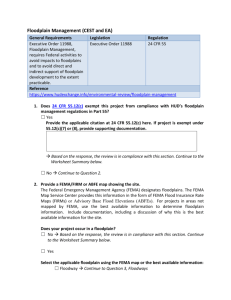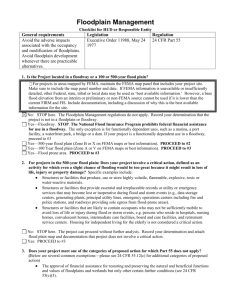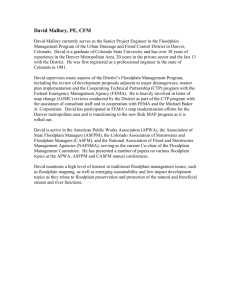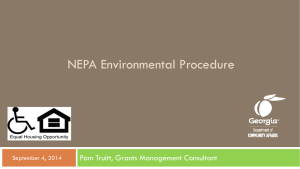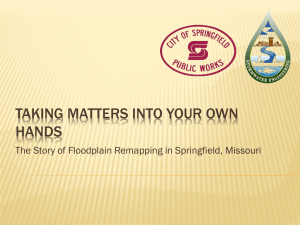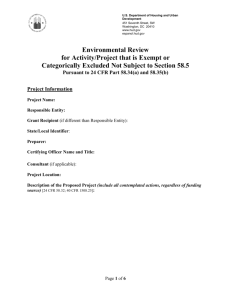Floodplain Management
advertisement
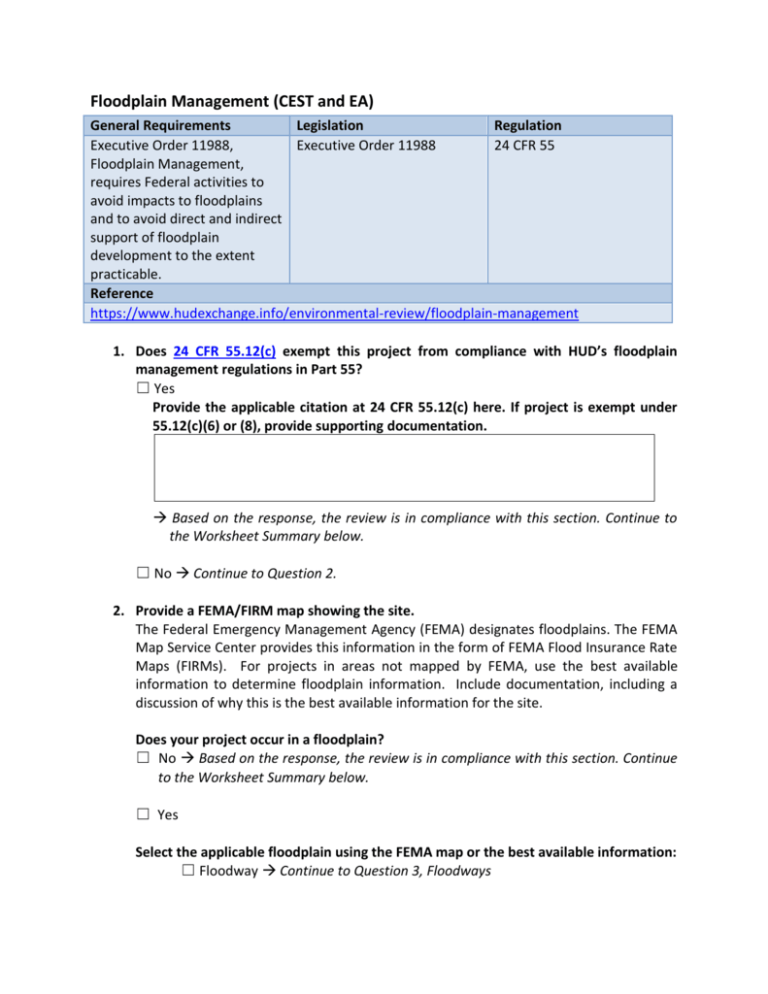
Floodplain Management (CEST and EA) General Requirements Legislation Regulation Executive Order 11988, Executive Order 11988 24 CFR 55 Floodplain Management, requires Federal activities to avoid impacts to floodplains and to avoid direct and indirect support of floodplain development to the extent practicable. Reference https://www.hudexchange.info/environmental-review/floodplain-management 1. Does 24 CFR 55.12(c) exempt this project from compliance with HUD’s floodplain management regulations in Part 55? ☐ Yes Provide the applicable citation at 24 CFR 55.12(c) here. If project is exempt under 55.12(c)(6) or (8), provide supporting documentation. Based on the response, the review is in compliance with this section. Continue to the Worksheet Summary below. ☐ No Continue to Question 2. 2. Provide a FEMA/FIRM map showing the site. The Federal Emergency Management Agency (FEMA) designates floodplains. The FEMA Map Service Center provides this information in the form of FEMA Flood Insurance Rate Maps (FIRMs). For projects in areas not mapped by FEMA, use the best available information to determine floodplain information. Include documentation, including a discussion of why this is the best available information for the site. Does your project occur in a floodplain? ☐ No Based on the response, the review is in compliance with this section. Continue to the Worksheet Summary below. ☐ Yes Select the applicable floodplain using the FEMA map or the best available information: ☐ Floodway Continue to Question 3, Floodways ☐ Coastal High Hazard Area (V Zone) Continue to Question 4, Coastal High Hazard Areas ☐ 500-year floodplain (B Zone or shaded X Zone) Continue to Question 5, 500-year Floodplains ☐ 100-year floodplain (A Zone) The 8-Step Process is required. Continue to Question 6, 8-Step Process 3. Floodways Is this a functionally dependent use? ☐ Yes The 8-Step Process is required. Work with your HUD FEO to determine a way to satisfactorily continue with this project. Provide a completed 8-Step Process, including the early public notice and the final notice. Continue to Question 7, Mitigation. ☐ No Federal assistance may not be used at this location unless a 55.12(c) exception applies. You must either choose an alternate site or cancel the project at this location. 4. Coastal High Hazard Area Is this a critical action? ☐ Yes Critical actions are prohibited in coastal high hazard areas. Federal assistance may not be used at this location. Unless the action is excepted at 24 CFR 55.12(c), you must either choose an alternate site or cancel the project. ☐ No Does this action include new construction? ☐ Yes, there is new construction. New construction must be designed to FEMA standards for V Zones at 44 CFR 60.3(e) (24 CFR 55.1(c)(3)(i)). Continue to Question 6, 8-Step Process ☐ No, this action concerns only existing construction. Existing construction must have met FEMA elevation and construction standards for a coastal high hazard area or other standards applicable at the time of construction. Continue to Question 6, 8-Step Process 5. 500-year Floodplain Is this a critical action? ☐ No Based on the response, the review is in compliance with this section. Continue to the Worksheet Summary below. ☐Yes Continue to Question 6, 8-Step Process 6. 8-Step Process. Does the 8-Step Process apply? Select one of the following options: ☐ 8-Step Process applies. Provide a completed 8-Step Process, including the early public notice and the final notice. Continue to Question 7, Mitigation ☐ 5-Step Process is applicable per 55.12(a)(1-3). Provide documentation of 5-Step Process. Select the applicable citation: ☐ 55.12(a)(1) HUD actions involving the disposition of HUD-acquired multifamily housing projects or “bulk sales” of HUD-acquired one- to four-family properties in communities that are in the Regular Program of the National Flood Insurance Program (NFIP) and in good standing (i.e., not suspended from program eligibility or placed on probation under 44 CFR 59.24). ☐ 55.12(a)(2) HUD's actions under section 223(f) of the National Housing Act (12 U.S.C. 1715n(f)) for the purchase or refinancing of existing multifamily housing projects (including hospitals, nursing homes, board and care facilities, and intermediate care facilities) in communities that are in good standing under the NFIP. ☐ 55.12(a)(3) HUD mortgage insurance actions for the repair, rehabilitation, modernization or improvement of existing multifamily housing projects (including nursing homes, board and care facilities and intermediate care facilities) and existing one- to four-family properties, in communities that are in the Regular Program of the NFIP and are in good standing, provided that the number of units is not increased more than 20 percent, the action does not involve a conversion from nonresidential to residential land use, and the footprint of the structure and paved areas is not significantly increased. Continue to Question 7, Mitigation ☐ 8-Step Process is inapplicable per 55.12(b)(1-4). Select the applicable citation: ☐ 55.12(b)(1) HUD's mortgage insurance actions and other financial assistance for the purchasing, mortgaging or refinancing of existing one- to four-family properties in communities that are in the Regular Program of the National Flood Insurance Program (NFIP) and in good standing (i.e., not suspended from program eligibility or placed on probation under 44 CFR 59.24), where the action is not a critical action and the property is not located in a floodway or coastal high hazard area. ☐ 55.12(b)(2) Financial assistance for minor repairs or improvements on one- to four-family properties that do not meet the thresholds for “substantial improvement” under § 55.2(b)(8) ☐ 55.12(b)(3) HUD actions involving the disposition of individual HUD-acquired, one- to four-family properties. ☐ 55.12(b)(4) HUD guarantees under the Loan Guarantee Recovery Fund Program (24 CFR part 573) of loans that refinance existing loans and mortgages, where any new construction or rehabilitation financed by the existing loan or mortgage has been completed prior to the filing of an application under the program, and the refinancing will not allow further construction or rehabilitation, nor result in any physical impacts or changes except for routine maintenance. Based on the response, the review is in compliance with this section. Continue to the Worksheet Summary below. 7. Mitigation For the project to be brought into compliance with this section, all adverse impacts must be mitigated. Explain in detail the exact measures that must be implemented to mitigate for the impact or effect, including the timeline for implementation. Which of the following mitigation/minimization measures have been identified for this project in the 8-Step or 5-Step Process? Select all that apply. ☐ Permeable surfaces ☐ Natural landscape enhancements that maintain or restore natural hydrology ☐ Planting or restoring native plant species ☐ Bioswales ☐ Evapotranspiration ☐ Stormwater capture and reuse ☐ Green or vegetative roofs with drainage provisions ☐ Natural Resources Conservation Service conservation easements or similar easements ☐ Floodproofing of structures ☐ Elevating structures including freeboarding above the required base flood elevations ☐ Other Based on the response, the review is in compliance with this section. Continue to the Worksheet Summary below. Worksheet Summary Compliance Determination Provide a clear description of your determination and a synopsis of the information that it was based on, such as: Map panel numbers and dates Names of all consulted parties and relevant consultation dates Names of plans or reports and relevant page numbers Any additional requirements specific to your region Are formal compliance steps or mitigation required? ☐ Yes ☐ No
